Research
Joe’s research contributions have helped build the emerging area of computational social science, which intersects data science with politics, economics, and business to produce interdisciplinary research applications. His research program innovates methodological techniques in data science and econometrics. He then applies these innovations to scholarly problems in the study of political polarization and democratic norms, as well as to practical business matters in advertising and quantitative finance.
Current Projects and Datasets
- State of the State Addresses, 1880–Present (SOTS), with Daniel M. Butler. In development, 2015–Present. Gubernatorial State of the State addresses, like small State of the Union addresses for each U.S. state, are demonstrative of the policy goals of the Governor and her party.
Papers
The Effect of Gender, Party and Seniority on Interruptions at Congressional Hearings (with Michael G. Miller)
We examine speech patterns during more than 25,000 committee hearings in the United States Congress from 1994 to 2018 to determine whether women are more likely to be interrupted than men. We find consistent evidence that women are indeed more likely to experience interruptions when they are speaking. This effect is especially strong among Members. Further analysis of speaker dyads suggests that this effect is driven by mixed-gender interactions; women are both more likely to be interrupted and more likely to interrupt, but these effects diminish significantly when two women are speaking to each other. We also consider the relationship between gender and interruptions under various legislative circumstances, and across the range of Member ideology; without exception, the core results endure.
Published in the American Political Science Review (APSR) [Paper] [Online Appendix]
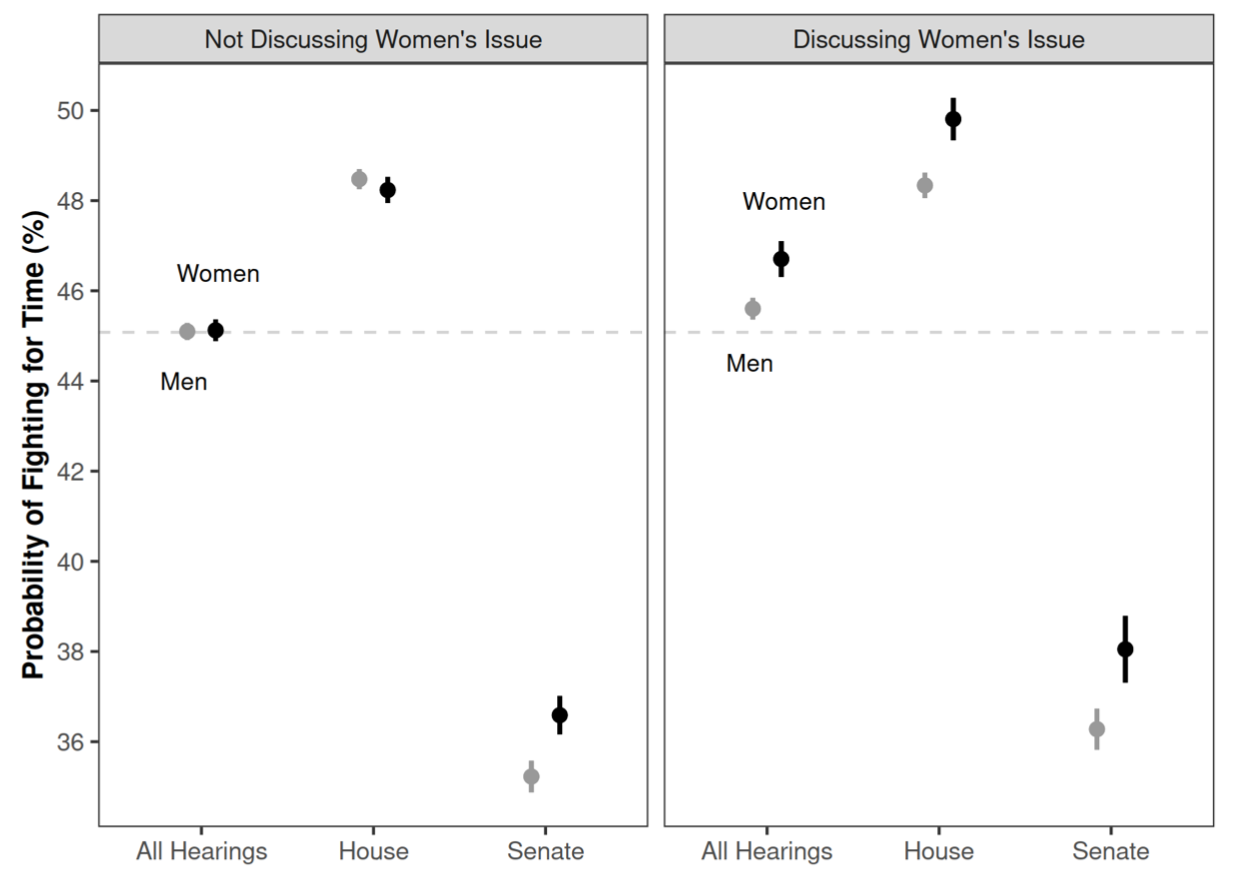
How Ideology Fuels Affective Polarization (with Jon Rogowski)
Scholars have reached mixed conclusions about the implications of increased political polarization for citizen decision-making. In this paper, we argue that citizens respond to ideological divergence with heightened affective polariza- tion. Using a survey experiment conducted with a nationally representative sample of U.S. citizens, we find that increased ideological differences between political figures produce increasingly polarized affective evaluations, and that these differ- ences are especially large among respondents with stronger ideological commit- ments and higher levels of political interest. We provide further support for these findings in an observational study of citizens’ evaluations of the U.S. Senators from their state. We also find that the polarizing effects of ideological differences can be largely mitigated with biographical information about the public officials, which suggests that the pernicious consequences of ideological polarization can be over- come by focusing on matters other than political disagreement.
Political Behavior (38), 485–508 [Paper] [Online Appendix]
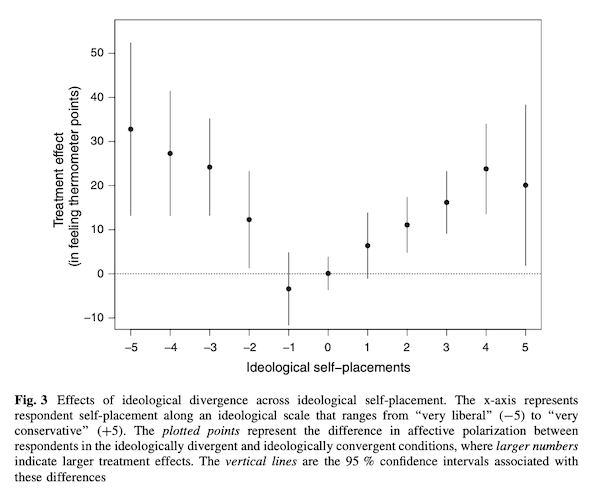
The Rise of Self-Censorship in America (with James L. Gibson)
This paper provides new data and analysis of the increasing trend of self-censorship among Americans from 1954 to 2023. Drawing upon a nationally representative survey, it reveals that 48% of Americans in 2023 feel less free to express their opinions, a slight increase from 46% in 2020. This trend is placed in historical context, showing a stark contrast with the 1950s, where only 13.4% felt a restriction in expressing their views despite the Red Scare’s potential repercussions. The paper explores various hypotheses for this rise in self-censorship, including affective polarization and support for civil liberties. Self-censorship is connected to affective polarization among the mass public, with greater polarization associated with more self-censorship. Levels of mass opposition to full civil liberties bear no relationship to self-censorship. This study highlights the significant implications of widespread self-censorship for the health of democracy in the United States, emphasizing the need to reduce the costs of expressing dissenting views to foster a more vibrant democracy.
“The Rise of Self-Censorship in America,” with James L. Gibson. In Maranto, Robert Anthony, Catherine Salmon, Lee Jussim, and Sally Satel. The Free Inquiry Papers. (Washington, D.C.: American Enterprise Institute, 2024). Ch. 8. [Paper] [Online Appendix]

Keeping Your Mouth Shut: Spiraling Self-Censorship in the United States (with James L. Gibson)
Over the course of the period from the heyday of McCarthyism to the present, the percentage of the American people not feeling free to express their views has tripled. In 2019, fully four in ten Americans engaged in self-censorship. Our analyses of both over-time and cross-sectional variability provide several insights into why people keep their mouths shut. We find that: (1) Levels of self-censorship are related to affective polarization among the mass public, but not via an “echo chamber” effect because greater polarization is associated with more self-censorship. (2) Levels of mass political intolerance bear no relationship to self-censorship, either at the macro- or micro-levels. (3) Those who perceive a more repressive government are only slightly more likely to engage in self-censorship. And (4) those possessing more resources (e.g., higher levels of education) report engaging in more self-censorship. Together, these findings suggest the conclusion that one’s larger macro-environment has little to do with self-censorship. Instead, micro-environment sentiments—such as worrying that expressing unpopular views will isolate and alienate people from their friends, family, and neighbors—might drive self-censorship. We conclude with a brief discussion of the significance of our findings for larger democracy theory and practice.
“Keeping Your Mouth Shut: Spiraling Self-Censorship in the United States”, with James L. Gibson. Political Science Quarterly 138, no. 3 (2023): 361-376. [Paper]
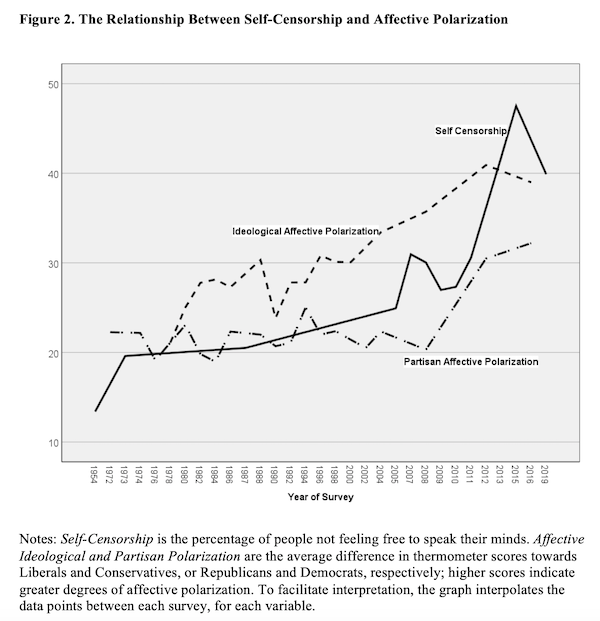
Have State Policy Agendas Become More Nationalized? (with Daniel M. Butler)
In recent decades, national factors (such as the president’s popularity) are increasingly predictive of electoral outcomes, at both the congressional and state level. We test whether the nationalization of state policy agendas is a contributing factor to the nationalization of gubernatorial elections. We measure the state agenda, by gathering governors’ State of the State (SOTS) addresses from the 1960 to 2016. Our analysis shows that state agendas have become more similar to each other over time, that state agendas are more similar to the national agenda (as laid out in the State of the Union – SOTU – address), and that the similarity between the state and national agendas predicts the degree to which national factors influence gubernatorial elections. Our results suggest that voters still engage in issue voting and that the nationalization of gubernatorial elections represents a rational response to the choices that voters face.
Journal of Poltics [Paper]
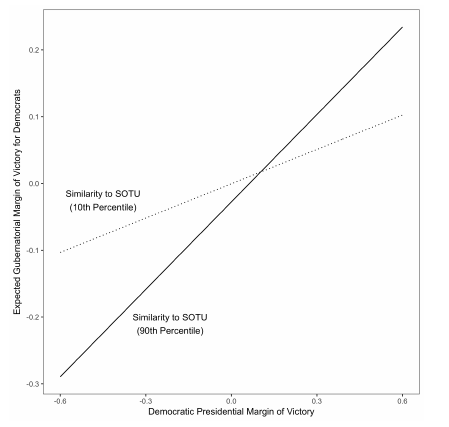
Multilevel customer segmentation for off-grid solar in developing countries: Evidence from solar home systems in Rwanda and Kenya (with Ryan Kennedy, Sini Numminen, and Johannes Urpelainen)
Off-grid solar systems have a number of advantages in developing countries, but they rely on the capacity of private entrepreneurs to develop a reliable customer base and methods for recruiting these customers. This study uses data from 68,600 customers of BBOXX, a London-based off-grid solar power company, to classify customers and explore the demographic and recruitment factors associated with customer behavior. We compare a non-parametric clustering method for customer segmentation with linear models of customer behavior. The results show a number of important demographic and geographic factors that influence recruitment of the company’s core customers, and demonstrates how linear models can be misleading. For example, women and those recruited by agent advertising or word-of- mouth are more likely in the company’s core clientele, even though the linear models suggest that they may be less profitable customers.
Energy (186), 115728 [Paper]

Can States Govern Effectively When Politics Are Nationalized?
I consider the question of whether electoral nationalization moderates the relationship between divided government and legislative productivity in the states. It takes as its unit of analysis the State over time. Conventional wisdom holds that divided control of the government hinders the ability of our elected representatives to govern, but research on whether this is the case has been a mixed bag. In this paper, I introduce new evidence by testing whether divided government affected lawmaking in the States from 1960–2012. I then test whether nationalization of electoral behavior is a part of this problem, arguing that nationalization is related to the ability to govern because of its close relationship with polarization and the incentives of elected representatives. I find a null effect of divided government on lawmaking ability. The approach shows evidence consistent with the “Mayhewvian” null findings on divided government, while adopting a similar, salience-based measurement approach of studies that do find an effect. I also find that while nationalization is not related to the ability of our state governments to take action on salient issues during times of divided government, nationalization of state legislatures has generally decreased the production of salient laws.
Working paper, comments welcome! Available upon request.
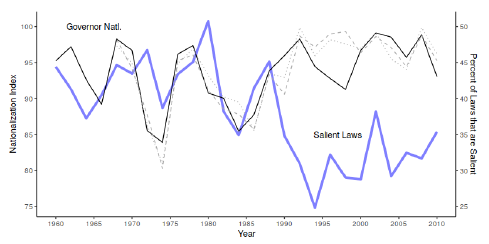
Campaign Surrogates, Minimal Effects, and Campaign Dynamics in the 2012 Presidential Election
The results of three studies are presented. The first introduces campaign surrogates – those who hold rallies on behalf of a candidate – and estimates their effect on county-level vote shares in the 2012 presidential election. The second demonstrates how campaigns deploy their scarce resources to maintain dynamic equilibrium, and how perturbations of that equilibrium might affect popular support for the candidates. The third study experimentally manipulates the information introduced by campaign events to gain intuition on why they are effective. The findings from these studies supplement the discussion of whether campaigns matter, and they further our understanding of strategic candidate interaction and voter behavior.
Working paper, comments welcome! Available upon request.
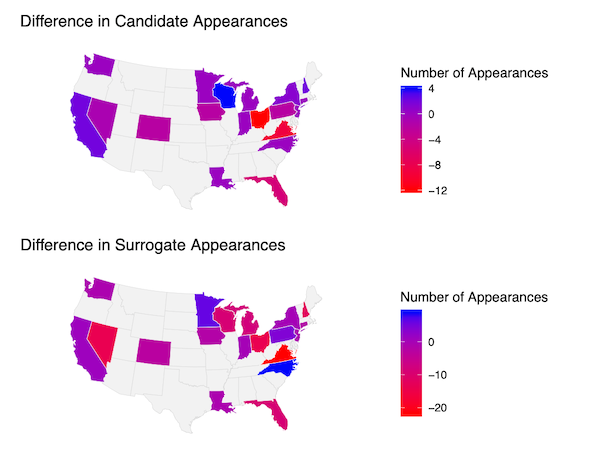
Encouraging Black and Latinx Radio Audiences to Register to Vote: A Field Experiment (with Hayley Cohen, Jose Gomez, Donald P Green, Michelle A Zee)
Traditional in-person voter registration drives increase voter registration rates in minority communities but became infeasible during the 2020 COVID-19 epidemic. An alternative approach is to promote registration through mass media, such as local radio. We present results from a large-scale experiment testing the effects of radio ads on voter registration. During the run up to the November 2020 election, we identified 186 radio stations with predominantly Latinx or African American audiences, covering tens of millions of voters; 50 randomly selected stations were assigned to a week-long advertising campaign each week for 3 weeks. Nonpartisan messages encouraged voter registration by stressing the importance of the election and featured celebrity voices. The number of new registrants rose slightly in treated areas during the week when the ads aired. No further gains were apparent one or 2 weeks later.
Cohen, Hayley, Jose Gomez, Donald P. Green, Joseph L. Sutherland, and Michelle A. Zee. “Encouraging Black and Latinx Radio Audiences to Register to Vote: A Field Experiment.” American Politics Research 51, no. 5 (2023): 559-569. [Paper]
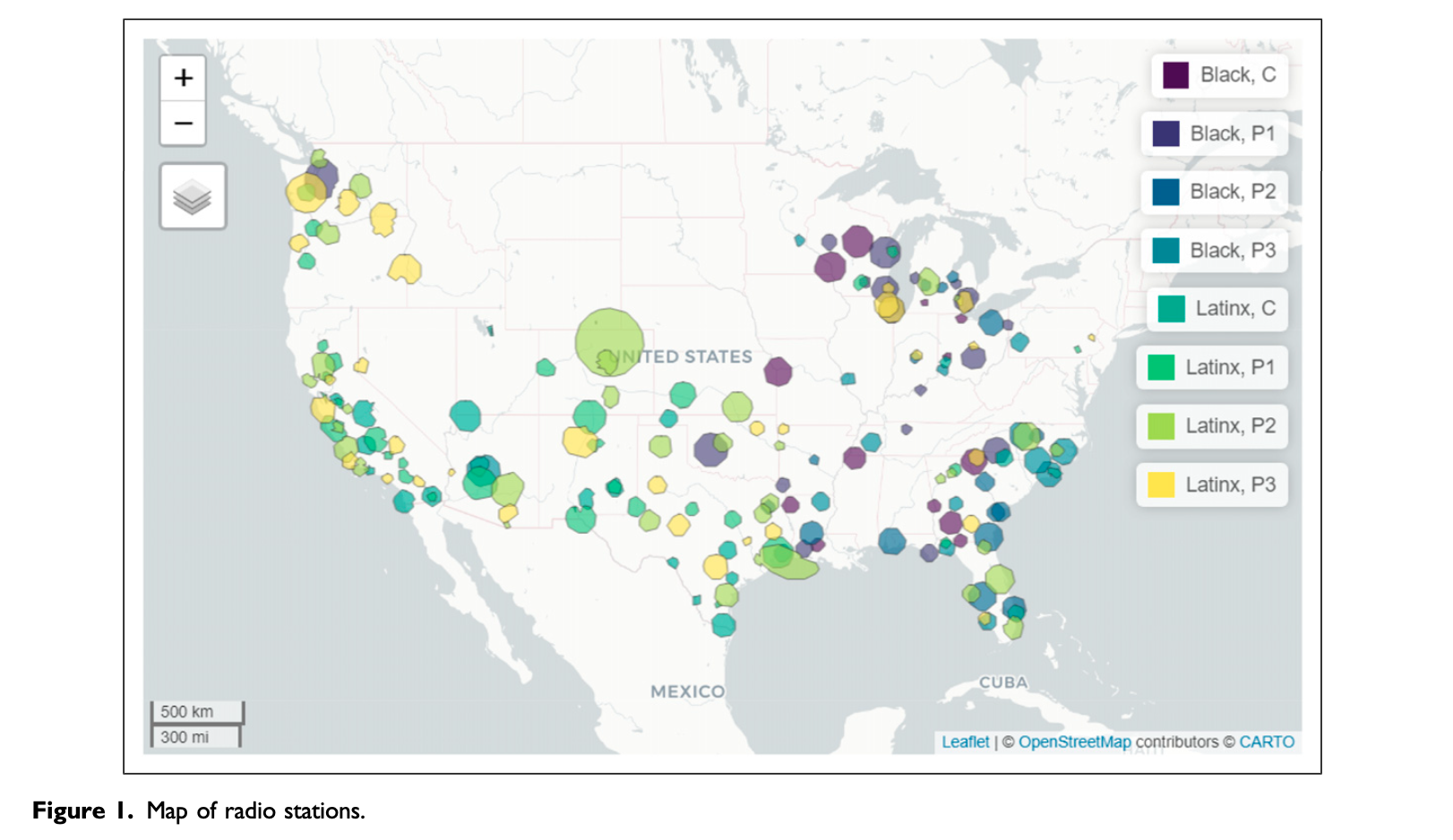
A Theory and Method for Pooling Naturally Distinct Corpora
This paper concerns the theory and method for why we should be able to use, pool, and compare the computer-generated codes from these naturally distinct text corpora to study nationalization. I propose a theoretical framework with which the researcher may defend the pooling of corpora, and introduce an empirical approach to testing for absolute comparability, the delta-statistic. While statistics like the Akaike Information Criterion (AIC) and penalized log likelihood can help the researcher to determine if a model fits the pooled corpora better than the corpora separately, the delta-statistic relies on a strong theory of latent traits to evaluate the absolute quality of a pooled model. This is especially important when it is impossible to evaluate ground truth fit because some data are unlabeled.
Working paper, comments welcome! Available upon request.
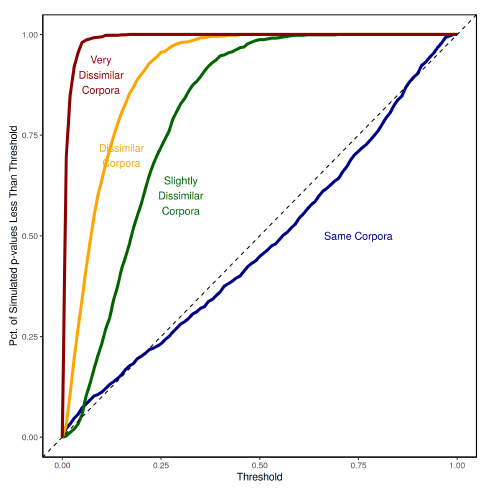
Open-Source Software
doc2text: Extract messy text blocks from images with computer vision.
- Open source software package that applies machine learning and computer vision to isolate, enhance, and extract text from hard-to-read documents. doc2text is different from other packages because it corrects for document layout problems with a novel statistical approach before running OCR, which results in significantly higher levels of accuracy. It gained notoriety as a top article on Hacker News and has been used for instructive purposes at Pennsylvania State University. This package is in the top 0.1% of projects on GitHub, with more than 1,000 stars (akin to Facebook “likes”) and 50 forks. [Link]